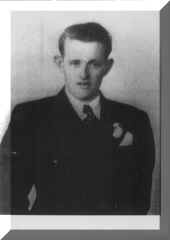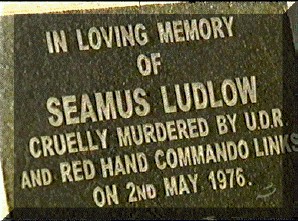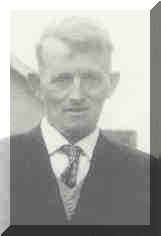


The Murder of Seamus Ludlow in County Louth, May 1976. Towards a public inquiry?
  
The Murder of Seamus Ludlow in County Louth, May 1976. Towards a public inquiry? |
|
The Ludlow Family excluded from the inquest, 19 August 1976. Seamus Ludlow was an innocent Catholic bachelor and a lifelong resident of County Louth, who was abducted and murdered south of the Irish border after leaving a Dundalk pub, on the night of 1st and 2nd May 1976. His killers are now known to have been members of the British Army's Ulster Defence Regiment (UDR) and the outlawed loyalist Red Hand Commando murder gang, an offshoot of the equally notorious Ulster Volunteer Force (UVF). . Seamus Ludlow was shot three times at close range and his body dumped on a ditch in a lane near his home. His Loyalist killers have never been brought to justice. However, it is now known that their identities were known to the Gardai and the RUC as late as 1979. It has now been revealed that the RUC had identified the four suspects as early as 1977! It appears that one of these four men, perhaps the actual killer, was an agent who reported back to his handlers almost immediately and informed them of his involvement in the crime. There is a strong suspicion that Seamus Ludlow's good name was smeared and his killers protected because the Gardai and the RUC wanted to protect an intelligence asset, perhaps the actual killer of Seamus Ludlow, within a Loyalist death squad. If this is true, then it can only be that Seamus Ludlow was expendable in the eyes of the Gardai and the Dublin authorities who were only concerned about protecting his evil killer, who remains free to this day and will never be brought to justice.
These Gardai lies originated very soon after the murder was committed with false claims that Seamus was killed by the IRA because he was an informer. The conspiracy against truth and justice was also evident at the original inquest into Seamus Ludlow, at which no member of the Ludlow family was present. Here, briefly, is a quote from The Dundalk Democrat report of the inquest: An inquest into the death of Seamus Ludlow, a forestry worker, aged 47, of Culfore, Mountpleasant, Dundalk, whose body was found on a quiet laneway near his home on a Sunday afternoon last May, revealed that he had been shot three times from very close range. The medical evidence of the State Pathologist at the inquest held in the Court House, Dundalk, on Thursday afternoon, also indicated that he could not have shot himself and was clearly done to death by a person or persons unknown. Another probability from the evidence was that the mnurdered man was not shot where his body was found on a grassy bank about 20 yards up the laneway from the bye-road leading from the main Dublin-Belfast Road at Thistle Cross to the Dundalk-Carlingford Road at Ballymascanlon. The inquest was incidentally, the first to be conducted in Dundalk by the newly appointed Coroner for Louth, Dr Thomas Edward Scully, Clogherhead. Evidence of identification was given by Sergt. James Gannon, Dromad, who described how he found the body of Seamus Ludlow lying on a grassy bank beside a hedge, about 12 yards from the junction with Ballymascanlon Thistle Cross bye-road at about 3.20 pm on the afternoon of Sunday May 2. The Sergt aso said that the body could not be seen from the bye-road. The Sergt. also said that the body was later identified to him by Kevin Ludlow, a brother of the deceased. He added that he himself had previously known Seamus Ludlow. Dr J.F.A Harbison, State Pathologist, gave evidence that he had visited the scene at Culfore at about 8 pm on May 2 where he saw the body lying on its back on top of a grassy bank. The head was towards the surface of the laneway and the feet towards the field. When he examined the body he saw what he first believed to be a stab wound on the chest, but this later proved to be incorrect as all wounds on the body were caused by bullets. . . Dr Harbison concluded by saying that he did not think the wounds could possibly have been self-inflicted. "In other words," he said, " I do not think this man could have shot himself." At the conclusion of the Pathologist's evidence, which was all the evidence offered to the inquest by the gardai, the foreman of the six-man jury, Mr James McCourt, Francis St., Dundalk, said that they did not think it was necessary to retire to consider a verdict. He said that they would return a verdict in accordance with the medical evidence, that death was due to gunshot wounds. Dr Scully, sympathising with the relatives of the deceased, a comparatively young man, said that this was a tragic hapening which was not a very frequent occurrence here. Insp. P.J. Farrelly, Dundalk, who had presented the evidence, was associated with the vote of sympathy, on behalf of the gardai . . . The Ludlow family was appalled to see this report in the local newspaper. An inquest for their loved-one had been held and they knew nothing about it. And, to this day, despite a fresh inquest in September 2005, despite the publication of the Barron Report in November 2005, and despite a serious of Oireachtas Justice sub-committee hearings in January and February 2006, the Ludlow family has never received a satisfactory or truthful explanation for their failure to receive advance warning! The family had no forewarning and no opportunity to attend. No doubt that is the very reason that the Garda failed to give warning. The Ludlow family would have insisted on hearing real evidence - ballistics and forensics. The family would have wanted to hear about the progress of the murder investigation. The family would have had legal representation to ensure that such important details were not overlooked. The Ludlow family believes that the inquest should have been adjourned! The Garda had not told the Ludlow family that the murder investigation had stopped after only 19 days! This would only be revealed by the Police Ombudsman for Northern Ireland nearly thity years later! The Ludlow family firmly believes that it was effectively excluded from the original inquest into the death of Seamus Ludlow in Dundalk on 19 August 1976. Very little information shedding new light on the death of Seamus Ludlow emerged from the inquest at that time. Until recent times, with the holding of a fresh inquest in September 2005, the family was never informed of the forensic or ballistics information which should have been available to the original inquest. In the course of 1998 the Ludlow family acquired, through a Newry solicitor, copies of three written depositions made to the inquest into the death of Seamus Ludlow. These depositions had never been seen by any member of the Ludlow family circle prior to 1998. The depositions were: by Kevin Ludlow, the victim's brother who identified the body of Seamus Ludlow; by Garda Sergeant Jim Gannon, Dromad Garda Station, who stated that he knew the deceased whom he discovered lying dead in the laneway; and from Dr. J.F.A. Harbison, Irish State Pathologist, who carried out a post mortem examination at the mortuary in the Louth County Hospital, at Dundalk As the Dundalk Democrat report above shows Sergeant Gannon and Professor Harbison were both present, while Kevin Ludlow was not! The Garda went to great lengths to keep the Ludlow family and its legal representatives away from the inquest of 19 August 1976. An approach was made to Mrs Agnes Ludlow, the wife of the victim's brother Kevin, who had identified the body, only 45 minutes before the inquest was set to begin. Kevin Ludlow was away at work and could not be contacted at such short notice. No attempt was made to inform Mrs. Nan Sharkey, the married sister, or her family, with whom the victim had resided at Thistlecross. Another brother and a sister living nearby were also available for contacting, but neither of them were informed.
The Ludlow family believes that they were deliberately excluded because the Garda did not want them to be present to ask awkward questions about the calibre of firearm used in the killing. No such information appeared in the rather sparse local newspaper reports of the inquest (see above) or indeed in the otherwise detailed pathologist's report which has only recently come into the Ludlow family's possession. No wonder that the family are asking, what were the Garda trying to hide from them? What dark secrets were being protected by keeping the Ludlow family away from the inquest? Was Seamus Ludlow shot by a man carrying a British Army weapon? The Ludlow family has in its possession written Garda claims that the family had been informed in advance of the inquest. These claims reveal the extent of the authorities' desire to cover-up the true circumstances of Seamus Ludlow's murder and also their insensitivity to the feelings of the victim's family. Detective Sergeant Jim Gannon (mentioned above), who was Sergeant at the nearby Dromad Garda Station, at the time of Seamus Ludlow's murder in 1976, wrote to a family solicitor on 16 January 1997. This letter was written just a year before the emergence of new information and the arrest of four Loyalists by the RUC in the North. D/Sergeant Gannon gave evidence at the inquest in August 1976 (see above) and he was involved in the initial murder investigation. In the course of his letter, D/Sergeant. Gannon wrote:
Clearly Mr. Gannon was misinformed and equally clearly neither he nor any other Garda officer brought the inquest to the notice of any other member of the Ludlow family circle. Mr Gannon (since retired) gave evidence at the fresh inquest in September 2005. His evidence regarding false claims he is alleged to have made of Ludlow family involvement in the murder of Seamus Ludlow was in conflict with evidence given by Kevin Ludlow. In November 1979 another Garda officer, Superintendent Richard Fahy, wrote to the late writer Michael Cunningham, and he stated: "A member of the Ludlow family was notified in advance of the date and time of the inquest." Mr. Fahy had a perfect recollection of something that simply never happened. Hopefully he will be more helpful if and when he is questioned before an inquiry in the near future. Many
questions were asked by friends and neighbours about the murder of
Seamus Ludlow. No doubt the Gardai were aware of these. There were
reports of British Army Special Air Service (SAS) hit squads operating
in the border area during the mid-1970s. There was suspicion that
eight SAS men arrested at Omeath just a few days after Seamus Ludlow's
murder may have been in some way responsible This is a photograph taken at the murder scene on the day after Seamus Ludlow's body was discovered. Various members of the Dublin murder squad, including John Courtney in civilian clothes at right, and Dundalk Gardai officers can be seen, but what were they looking for? As with everything else in this sad case, they were searching for the killers in the wrong place. There were reports of republicans in the Dundalk area appearing in Northern courts, having been snatched by British Army undercover squads. There were rumours that Seamus Ludlow closely resembled a known republican who lived in Dundalk and that he may have been a victim of mistaken identity, killed by men sent to snatch or kill the other man. This theory was reported by John Keane in the Sunday World newspaper, 16 May 1976. There were reports from a petrol pump attendant along the Newry Road of two men with English accents buying petrol on the night of Seamus Ludlow's murder, though no clear link with his death has been established. John Keane in the Sunday World newspaper of 16 May 1976 reported that local people he had seen "say that the sleeves of the murdered man's coat were ripped out. This could be relevant to the mistaken identity theory, for the Provo marksman they may have thought they had "lifted" is tattooed on both arms". Latest: In 2002, the Irish Attorney General ordered a fresh inquest into the death of Seamus Ludlow. This inquest did not take place until 2/3 September 2005.
I Top I The Argus, 27 August 1976: Inquest hears of North Louth shooting Monaghan County of Intrigue (1979) by the late Michael Cunningham: Quoting from Mr. Cunningham's account of his private investigation of Seamus Ludlow's murder
Download the Barron Report from the Oireachtas website (pdf file) SUPPORT THE SEAMUS LUDLOW APPEAL FUND Bank of Ireland 78 Clanbrassil Street Dundalk County Louth IrelandAccount No. 70037984 Thank You.
|